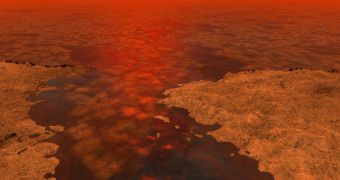Titan has long been one of the most interesting bodies in the solar system. Saturn's moon may be quite alien, but it's more similar to Earth than anything else that we know of, in some respects.
It's the one place in the solar system, apart from Earth, that has lakes, seas, rivers and rain. Scientists now want to add ice blocks floating on the liquid surface to the mix.
There is a slight caveat though, this is all made up of liquid or frozen hydrocarbons and not water. These substances are gaseous on Earth, but the freezing Titan is at just the right temperature to keep them in liquid form.
The existence of ice blocks on the liquid surface would explain some of the strange readings the Cassini probe got in the past, the reflectivity changes seen by different passes.
The reason why floating ice hasn't been considered before is that hydrocarbon ice is heavier than the liquid form so any ice would sink to the bottom. But scientists believe that different mixtures or pockets of gas could keep the ice afloat.
This is only true for ice very near to the freezing point of the hydrocarbons, 90.4° Kelvin, or -182.75° Celsius, -297° Fahrenheit for methane.
The floating ice theory is just that, a theory, for now, but Cassini will soon be able to put it to the test as spring comes in parts of Titan.
As the temperature rises, sunken ice should float back up to the surface which will be more reflective to Cassini's instruments. After it melts, the surface of the lakes should become darker again.
"We now know it's possible to get methane-and-ethane-rich ice freezing over on Titan in thin blocks that congeal together as it gets colder -- similar to what we see with Arctic sea ice at the onset of winter," Jason Hofgartner, first author of the paper describing the new ideas, said.

 14 DAY TRIAL //
14 DAY TRIAL //